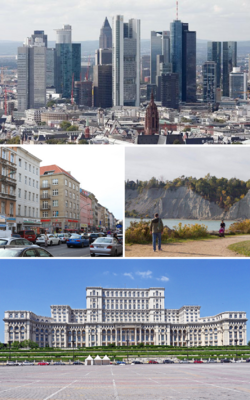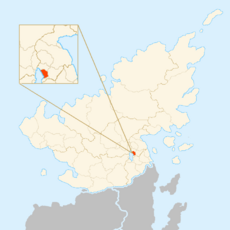Conelibek
This article is incomplete because it is pending further input from participants, or it is a work-in-progress by one author. Please comment on this article's talk page to share your input, comments and questions. Note: To contribute to this article, you may need to seek help from the author(s) of this page. |
City Municipality of Conelibek
Vila-Komyn á Conélibekya | |
|---|---|
City | |
 | |
 Location of the City Municipality of Conelibek | |
| Country | |
| Province | |
| Government | |
| • Mayor | Dani Kjord |
| Area | |
| • City | 76.6 km2 (29.6 sq mi) |
| Population | 827,193 |
| • Density | 10,799/km2 (27,970/sq mi) |
| • Metro | 1,280,098 |
| • Summer (DST) | UTC= |
| Website | conelibek |
Conelibek (Seketese: Conélibek), officially the City Municipality of Conelibek (Seketese: Vila-Komyn á Conélibekya), is the capital and largest city of Seketan. The city is a municipality and has special status as a city municipality. Located on the eastern shore of Lake Seketan in the smallest but most populous province of Gjenor, Conelibek serves as a provincial and national capital. With a population of 827,193, Conelibek is Seketan's most populous municipality. The city has an area of 76.6 km2 and has a population density of 10,799 people per km2, making Conelibek one of the most geographically smallest but most densely populated city propers in Europe.
Conelibek is the cultural, governmental, and economic centre of Seketan. It is an important transportation hub in the Nelborne and Central Seketan region: the lake offers naval routes to other major cities across four different provinces, the Conelibek Metro is the busiest in the country, and the Conelibek International Airport is the busiest airport in the Nelborne. The city is the home to many Seketese corporations, such as Gyenor Corporation, SBC, and Esta. The city serves as one of the government centres for the Nelborne Union and for the Nelbec Council.
The city was established sometime between the 5th and 6th century by the Conils tribe, for which the city is named after. As the dominant Secenic tribe at the time, the Conils conquered and prevailed. The leaders of the tribe designated themselves as the Cothepag dynasty. When the dynasty ruled over the Secenic Confederation, Conelibek was chosen as the governmental centre. This carried forward when the personal union evolved into the Kingdom of Seketan. The Covrig Palace, Totjen Cathedral, and other impressive structures were erected in the city during the Late Middle Ages and Early Modern Era. The city became heavily industrialized in the 19th century. Conelibek and its surrounding areas were repeatedly damaged throughout the 20th century due to various conflicts including the Seketese War of Independence, the Seketese Civil War, and the Great Nelborne War. The city developed its metro in 1975.
Conelibek is governed by the Conelibek Assembly that is led by a directly-elected mayor. The mayor and elected members of the assembly traditionally must join the Société Conelibek, a nonpartisan organization, but most are unofficially affiliated. Conelibekians hold a strong cultural identity with their own music, art, architecture, and accent. The flag of Conelibek is an iconic symbol whose imagery can be seen throughout the city.
Etymology
The name of Conelibek is named after the Conils, a Secenic people who later led the Secenic Confederation. Libek is an Old Seketese word for city.
History
Early history
Middle ages
Industrial revolution
Revolutionary period
Since 1921
Geography
Climate
Administration and infastructure
City government
Healthcare
Education
Police
Transport
Metro
The Conelibek Metro serves as the city's rapid transit.
